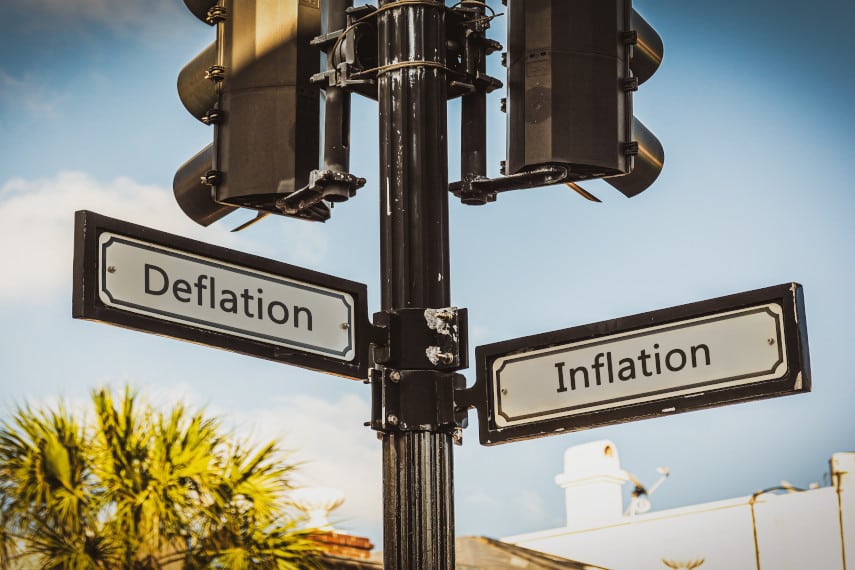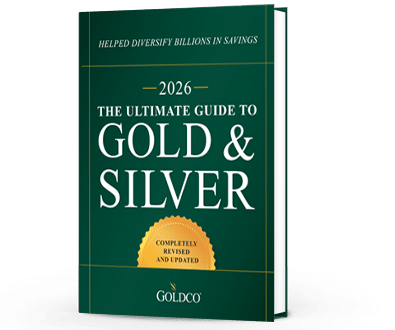6 Indicators of a Potential Recession
It seems that in the media today there are more and more mentions of the dreaded R-word: recession With growing economic uncertainty, the threat of potential recession seems to be growing as...
Economy

While inflation has been on the minds of millions of Americans in recent weeks, and has dominated discussion among financial media analysts, there are still some pundits who are worried about the opposite: deflation. Since the 2008 financial crisis, there have been more than a handful of analysts who have tried to claim that deflation, not inflation, is the real problem. Are they right?
It’s important to make a distinction first between inflation and deflation and the competing definitions of those terms. Then we can analyze the different meanings and concepts and what effects inflation and deflation might have on the economy and on your investments.
Inflation has historically been defined as an increase in the money supply, or sometimes more specifically as an increase in the money supply above and beyond what the market demands. Deflation was then defined as a decrease in the money supply. The effect of inflation, all other things being equal, is a rise in prices. And the effect of deflation would be a fall in prices.
Today mainstream economics has confused cause with effect, and inflation is defined as a rise in the general price level. That’s why you’ll see such a focus on price level statistics such as the consumer price index (CPI), producer price index (PPI), and personal consumption expenditures (PCE). Deflation then is defined today as a decline in the general price level.
Now that we have the definitions out of the way, let’s look at them in greater depth.
If we define inflation as an increase in the money supply, there’s no doubt that we’re in the middle of a highly inflationary environment. The Federal Reserve has doubled the size of its balance sheet over the past year, to more than $8 trillion. And it continues to purchase Treasury securities and agency mortgage-backed securities at a pace equal to nearly $1.5 trillion per year.
The effect on money supply figures was profound, with both the M1 and M2 money supply figures seeing huge double-digit increases last year. In fact, the Fed decided to recalculate the way that it calculated money supply figures in an attempt to downplay the effects of its monetary policy and keep the public from seeing just what effects its ultra-loose monetary policy is having on the money supply.
As consumers have seen over the past several months, this increase in the money supply has had the effect of raising prices throughout the economy. Despite an economy that is somewhat recovered, economic production hasn’t surpassed pre-lockdown levels, and thus all this additional money is helping to drive prices higher.
If you define inflation as an increase in prices, as most economists do today, then there’s again no doubt that we’re in an inflationary environment. Year-on-year inflation recently hit 5%, and there’s no telling how much higher it could climb.
The Federal Reserve believes that inflation is only transitory, exacerbated by supply issues remaining within the economy. And the general belief is that inflation will die down towards the end of the year.
The big question is: what happens if inflation doesn’t die down? What happens if year-on-year inflation declines but the annual CPI increase starts to increase significantly? Will the Fed admit its role in helping push prices higher, or will it continue to wash its hands of any responsibility?
In the traditional sense, deflation was understood as a decline in the money supply. Under a normal, gold-based monetary system there would normally be no real deflation, as production of gold would offset the loss of gold through wear.
Normally deflation comes about as the result of monetary manipulation, as when a central bank that has increased the money supply suddenly decides to decrease the money supply. As the increase in the money supply has a stimulating effect on the economy, decreasing the money supply has a depressing or recessionary effect on the economy. And because the money supply is decreasing, each unit of the currency gains purchasing power, thus resulting in a fall in prices.
It is the recessionary effects of deflationary monetary policy that has so many pundits today warning about deflation. But they’re worried about falling prices, not a decrease in the money supply. They too have confused cause and effect, so that any fall in prices is seen as “deflationary.”
But prices can fall for other reasons too, such as significantly increased production. Indeed, the economic literature often refers to the period from 1873-1896 as the Long Depression because prices fell continuously throughout that period. But economic output climbed throughout that period. The natural result of rising production, all other things being equal, is a fall in prices.
It is only in hindsight that that era has been labeled a depression, by historians and economic illiterates who confuse falling prices with a falling money supply. Falling prices resulting from increased production is good for the economy, while falling prices resulting from a forced decline in the money supply is bad.
Because of that confusion over the definitions of inflation and deflation, there is a lot of misinformation out there about the dangers of deflation. Any time prices begin to fall, you’ll hear warnings of coming deflation. Yet in reality the cause of most prices falling isn’t’ in fact a decline in the money supply. If you look at money supply figures, they’ve been moving consistently upward for decades, so falling prices are normally the result of some other cause.
You may be familiar with the rising price of lumber over the past several months. Go to your local hardware store for some 2x4s or a sheet of plywood and you’ll probably be aghast at how expensive they’ve gotten. Yet lumber prices are beginning to fall significantly, at least at the wholesale level.
The fact that lumber prices are falling despite the money supply increasing means that some other factor must be at work. Most likely it’s a combination of builders holding off on projects due to high lumber prices and increased capacity from sawmills. But falling lumber prices doesn’t mean that we’re suddenly seeing deflation, especially since even if prices fall still further they’ll still be double their pre-COVID levels.
Even if prices for other goods such as food and housing begin to fall, it again will likely not be the result of deflation. So the next time you hear someone fretting about deflation, known that they’re worried about falling prices, not a sudden decrease in the money supply. Active contraction of the money supply is harmful, but falling prices are not, especially if it means your standard of living is getting cheaper and your dollars are going farther than they used to.
Since the Fed is going to keep pursuing inflationary monetary policy, it’s really inflation that is the major threat in the coming years, not deflation. And that means investors will have to learn how to protect their assets against inflation, something they haven’t had to do for over a decade.
We could very well see a return to the high inflation environment of the 1970s and early 1980s, when inflation hit double digits at times. That kind of inflation could take a big bite out of investment returns for those who don’t expect it or plan for it.
One of the traditional assets trusted to protect against inflation is gold, which has helped protect wealth for centuries. During the stagflationary 1970s, gold’s average annualized gains were over 30%, far outpacing inflation and outperforming stock markets.
Gold also performed well in the aftermath of the 2008 financial crisis, nearly tripling in value from 2008 to 2011. Many people who saw that performance vowed that they would invest in gold the next time such a crisis became a possibility. Are you one of them?
If you haven’t already protected your savings with gold, now is the time to start thinking about it. Investing in gold can be as easy as opening a gold IRA, an investment vehicle that allows you to invest in physical gold coins or bars while still enjoying the same tax benefits as a conventional IRA account. And if you have existing retirement savings in a 401(k), IRA, TSP, or similar retirement account, you can roll over or transfer those funds into a gold IRA without suffering any tax consequences.
Don’t let your wealth fall victim to inflation. Talk to the precious metals experts at Goldco today to learn more about how gold can protect and safeguard your savings.

